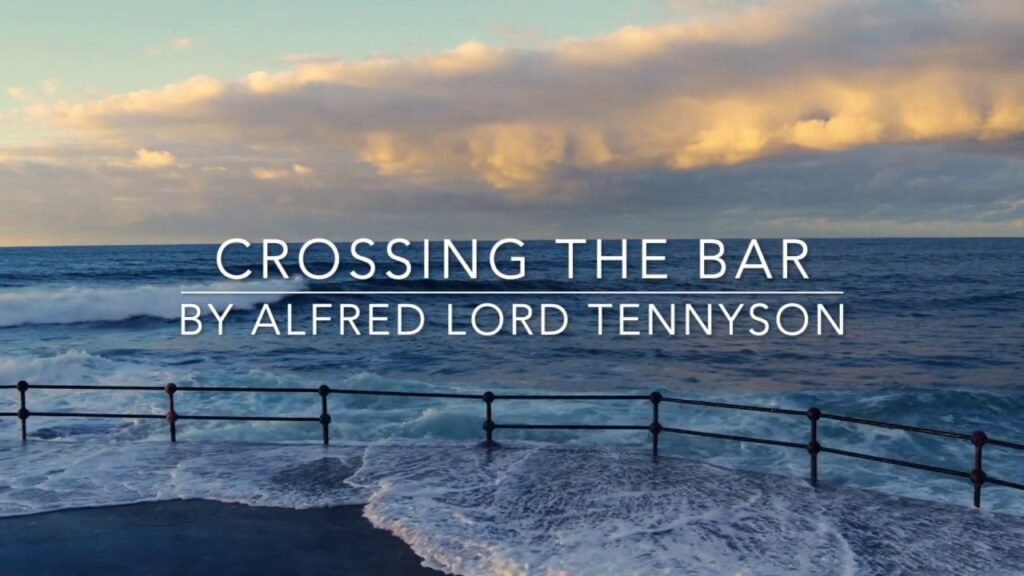Alfred Lord Tennyson, one of the most celebrated poets of the Victorian era, wrote “Crossing the Bar” in 1889, just a few years before his death. This poem is considered a profound reflection on death, the afterlife, and the peaceful acceptance of life’s inevitable end. Through its clear, serene, and spiritual themes, “Crossing the Bar” remains one of Tennyson’s most famous works. In this article, we will explore the background of the poem, summarize its plot, analyze the key details, and discuss the settings that shape its overall mood. Additionally, we will outline practical class activities and assignments that will help students better understand this literary masterpiece.
Background to the Book
“Crossing the Bar” was written at a time when Tennyson, aware of his own mortality, was contemplating the meaning of life and death. It was published in The Cornhill Magazine in 1889 and reflects his own reflections on life’s transience. The “bar” in the title refers to a sandbar, which in maritime terms is an underwater ridge near the shore that can pose a dangerous obstacle for ships. This metaphor was used by Tennyson to depict the transition from life to death, with the crossing representing the soul’s journey from the earthly realm to the afterlife. The poem was written at the request of Tennyson’s family to be included as a posthumous piece in his collected works, and it was one of the last poems he ever wrote.
Summary of the Poem
The poem consists of 16 lines divided into two stanzas. It is deeply reflective and speaks of the poet’s peaceful acceptance of death. The first stanza describes the approach of death as a “bar” to be crossed. Tennyson imagines his soul embarking on a final voyage, with the “pilot” symbolizing God or divine guidance who will guide him safely across to the afterlife.
In the second stanza, Tennyson expresses a calm acceptance, even a sense of readiness, for the journey. He requests that no mourning or sorrow accompany him, as he sees death not as an end but as a transition to something better. The poem ends with a hopeful note of reunion with God, representing the poet’s belief in an afterlife.
Key Plot Details
The poem’s simplicity belies its profound depth, with a few key themes at the heart of its meaning:
- Death as a natural part of life: Tennyson presents death as a peaceful passage, something to be approached with calm and dignity rather than fear.
- The transition from life to the afterlife: The metaphor of the bar represents the boundary between life and death, and the crossing symbolizes the transition of the soul.
- Divine guidance: The “pilot” represents divine will, suggesting that death is not something to be feared but rather a journey guided by a higher power.
- Acceptance and tranquility: The speaker shows no fear or reluctance about the end of life but instead a serene acceptance, indicating a deep trust in the afterlife and a belief in God’s plan.
Settings of the Poem
The setting of “Crossing the Bar” is symbolic rather than literal. The primary setting is the sea, which reflects the unknown journey of death. The “bar” itself represents the boundary between life and death, and the poet’s reference to the “Pilot” suggests that the speaker is being guided to the next phase of existence. The gentle imagery of the setting creates an atmosphere of calm, emphasizing the idea that death is not a terrifying event but a natural transition.
Tennyson employs a calm and gentle tone, using maritime imagery to evoke a sense of peace and resolution. The setting does not feature a tumultuous storm or an angry sea, as one might expect from poems about death. Instead, the sea is a serene, quiet place that reflects the poet’s acceptance and readiness for the journey ahead.
Class Activities
- Poetry Analysis: Have students break down the poem stanza by stanza. Ask them to identify the key metaphors used by Tennyson and discuss what each symbolizes in relation to life, death, and the afterlife.
- Artistic Interpretation: Ask students to create an artistic representation (drawing, painting, or collage) of the metaphorical “bar” Tennyson references. What does it symbolize for them?
- Comparative Study: Compare Tennyson’s “Crossing the Bar” with another poem that deals with death, such as Emily Dickinson’s “Because I Could Not Stop for Death.” Have students discuss the different perspectives on death in each poem.
- Creative Writing Exercise: Have students write a short poem or essay from the perspective of someone about to cross the “bar.” They should reflect on their own thoughts about mortality and what the journey to the afterlife might entail.
- Debate: Host a class debate on the theme of death as a natural part of life. Have one group argue that death should be feared, while the other group argues that it should be accepted as a peaceful transition.
Class Assignments
- Poem Reflection: Write a one-page reflection on how the poem changes the way you think about death and the afterlife.
- Metaphor Analysis: Choose one metaphor from the poem (e.g., the “bar” or the “pilot”) and explain what it symbolizes in the context of the poem’s themes.
- Poem Paraphrasing: Paraphrase the poem in modern language while keeping its original meaning intact. This will help students understand the poetic devices used by Tennyson.
- Research Assignment: Research the life of Alfred Tennyson and discuss how his personal experiences, such as the death of his close friend Arthur Hallam, may have influenced the themes in this poem.
Death and Afterlife Survey: Conduct a survey within the class about students’ views on death and the afterlife. Have them compare their personal beliefs with the ideas expressed in the poem.
Crossing the Bar
by Alfred, Lord Tennyson
Sunset and evening star,
And one clear call for me!
And may there be no moaning of the bar,
When I put out to sea,
But such a tide as moving seems asleep,
Too full for sound and foam,
When that which drew from out the boundless deep
Turns again home.
Twilight and evening bell,
And after that the dark!
And may there be no sadness of farewell,
When I embark;
For though from out our bourne of Time and Place
The flood may bear me far,
I hope to see my Pilot face to face
When I have crossed the bar.
Conclusion
“Crossing the Bar” by Alfred Tennyson stands as a testament to the poet’s philosophical and spiritual reflection on death. Through serene and powerful imagery, Tennyson conveys a calm acceptance of mortality, urging readers to embrace death as a natural passage guided by divine will. With its timeless themes of life, death, and the afterlife, the poem continues to resonate with readers today, offering solace and reflection.




